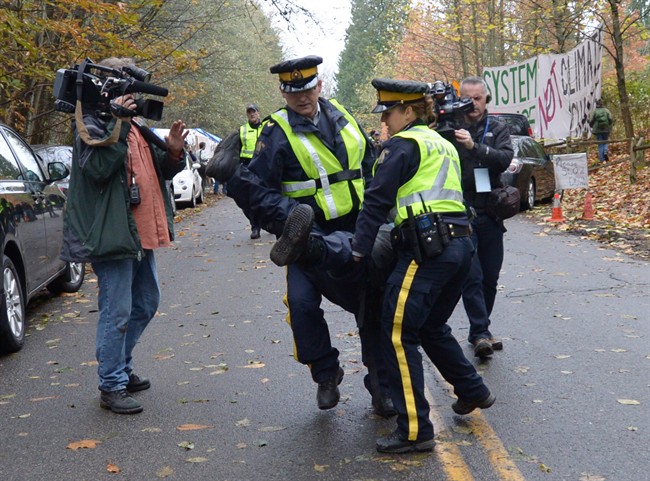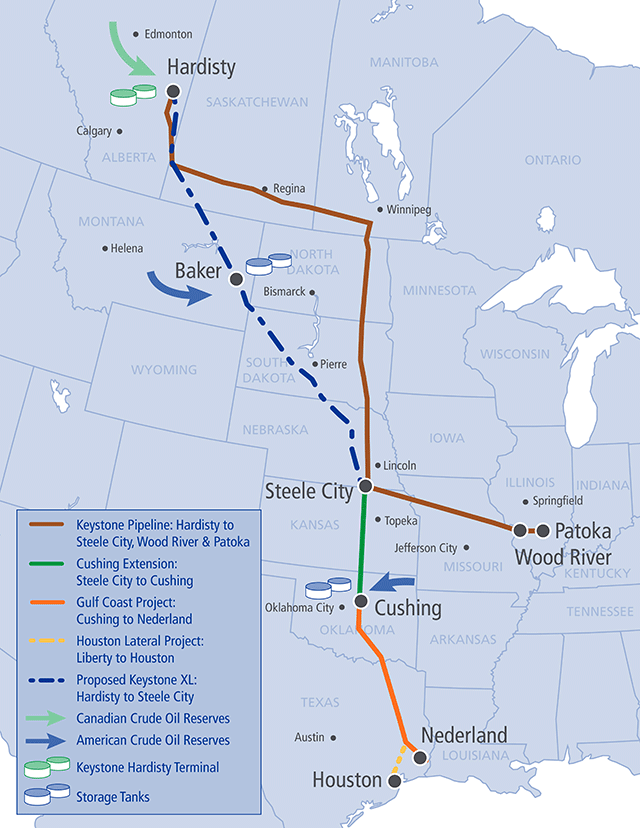In 2014 we saw government ads, international talks, protests and arrests related to four major proposed pipeline projects. Will 2015 be the year any of these finally break ground?

For the most part: no. Almost all of these projects are still awaiting one form of approval or another – a process which takes years. While it’s possible that decisions might be made on some of them in 2015, it’s still too soon for construction to begin.
The exception is Enbridge’s Line 9, which could in theory start full operation this year.
Here’s where the projects are at:
Keystone XL
This pipeline will carry oil from Hardisty, Alberta, to Steele City, Nebraska, with a capacity of 830,000 barrels per day.
According to the National Energy Board, the project has been approved on the Canadian side, and now, it’s up to the Americans.
The Senate rejected a fast-track approval in November. However, there will be a new Senate next year, with more Republicans who are expected to be more in favour of the project. There have also been a variety of legal challenges to the project, which would have to be dealt with.
Still, the ultimate decision-making power rests with U.S. President Barack Obama, and despite heavy marketing and diplomatic efforts from the Canadian government, it’s still uncertain which way he will go.
It’s entirely possible he will make a decision in 2015, though as the Keystone XL website notes, the pipeline isn’t projected to be in service until two years after a presidential decision. So, 2016-2017 at the earliest.
Energy East

This pipeline, if built, will carry oil from Alberta and Saskatchewan to Quebec and New Brunswick. The capacity is 1.1 million barrels per day, according to TransCanada, the operator.
The bulk of the pipeline is actually a conversion – changing an existing natural gas pipeline into an oil one. Some additional sections of oil pipeline will be constructed too, largely to extend it further east. Some oil terminals will also be built.
This pipeline is extremely early in the approvals process. They only filed an application to the NEB in October 2014. If the application contains everything it is supposed to, says the NEB, then the board will announce hearings sometime in the first quarter of 2015, and the hearings process will continue throughout the year.
Once that hearing order is issued, the NEB has 15 months to deliver a report, which would easily bring us to the middle of 2016. Then, the government has three more months to review the NEB’s recommendation and deliver a final decision. Construction of this project is a long way off.
Trans Mountain expansion
This project is an expansion of Kinder Morgan’s existing pipeline, which runs for 1,150 kilometres between Strathcona County in Alberta and Burnaby, B.C. The expansion will essentially twin the pipeline, increasing its capacity to 890,000 barrels per day.
The company filed a project application in December 2013, and the NEB pushed back the hearing schedule to ask for more information from Trans Mountain. Part of this process had the company out drilling to assess the geological composition of Burnaby Mountain, where they were met by protests.
Still, because of the revised timeline, while there will be comments and hearings in 2015, the NEB is not required to issue a decision until January 2016. So, there will be no construction this upcoming year.
Northern Gateway
The Northern Gateway pipeline will run 1,177 kilometres (“rational and respectful” kilometres, according to the project’s website) from Bruderheim, Alberta, to Kitimat, B.C. It will be a twin pipeline, with the westbound route carrying up to 525,000 barrels of oil per day, and the eastbound route carrying up to 193,000 daily barrels of condensate – a chemical used to thin bitumen to make it more easily transportable.
The NEB approved the project in June 2014. However, the board imposed 209 conditions on the approval – 113 of which must be completed before construction can begin. These include things like meeting with First Nations groups along the route to discuss employment opportunities and fish habitat compensation, and building fences around burial sites.
Documentation related to many of these conditions must be submitted to the NEB a year in advance of construction. Given that the NEB doesn’t have this yet, it’s unlikely that construction could begin in 2015.
Line 9

Unlike many of the other major projects, this is not a brand-new pipeline. Rather, Enbridge wishes to reverse the flow of an existing pipeline between Sarnia, Ontario, and Montreal, Quebec, and expand its capacity.
The project was approved with conditions in March 2014 and most of the work has been completed. However, in October, the NEB told Enbridge that it was not convinced that all the safety-related conditions have been met. They were concerned about one in particular: shut-off valves along major water crossings. As such, the pipeline’s opening date was delayed.
Enbridge responded in late October, but the NEB is still reviewing the response, and there is no timeline for when it has to deliver a decision. And, the board says that Enbridge is required to submit a final “leave to open” application, which it has yet to do. So although oil is currently flowing in a small section of the pipeline, the rest has yet to be started up. This could possibly happen in 2015 though.





Comments